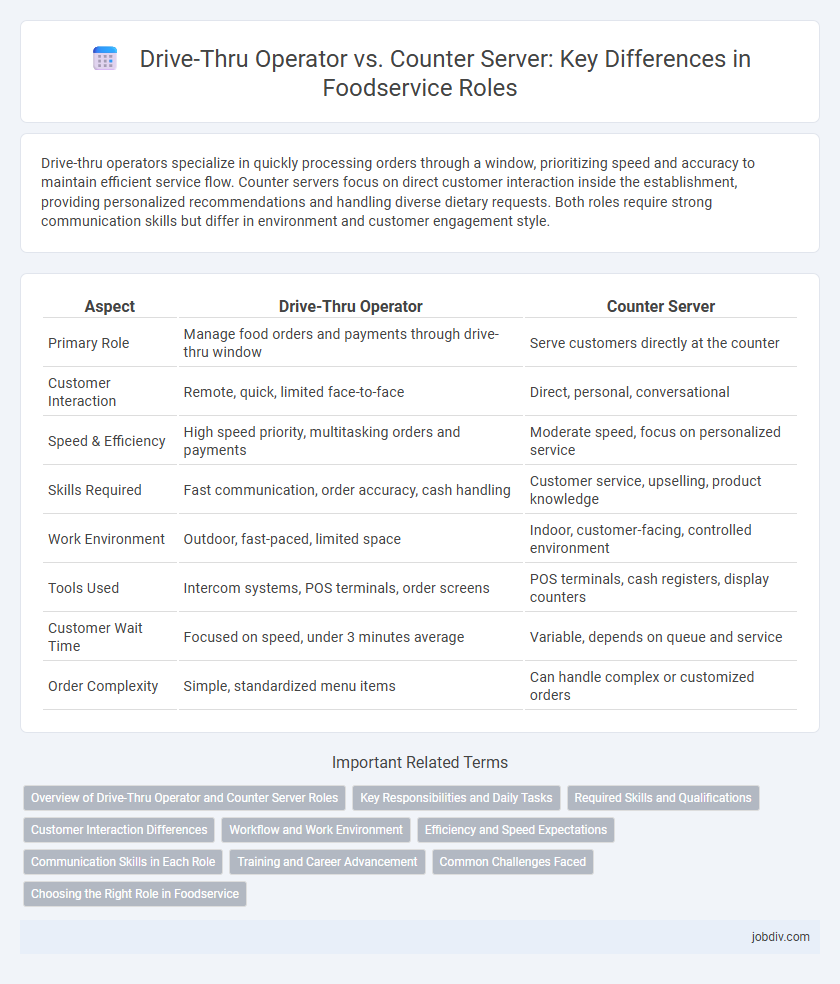Drive-thru operators specialize in quickly processing orders through a window, prioritizing speed and accuracy to maintain efficient service flow. Counter servers focus on direct customer interaction inside the establishment, providing personalized recommendations and handling diverse dietary requests. Both roles require strong communication skills but differ in environment and customer engagement style.
Table of Comparison
| Aspect | Drive-Thru Operator | Counter Server |
|---|---|---|
| Primary Role | Manage food orders and payments through drive-thru window | Serve customers directly at the counter |
| Customer Interaction | Remote, quick, limited face-to-face | Direct, personal, conversational |
| Speed & Efficiency | High speed priority, multitasking orders and payments | Moderate speed, focus on personalized service |
| Skills Required | Fast communication, order accuracy, cash handling | Customer service, upselling, product knowledge |
| Work Environment | Outdoor, fast-paced, limited space | Indoor, customer-facing, controlled environment |
| Tools Used | Intercom systems, POS terminals, order screens | POS terminals, cash registers, display counters |
| Customer Wait Time | Focused on speed, under 3 minutes average | Variable, depends on queue and service |
| Order Complexity | Simple, standardized menu items | Can handle complex or customized orders |
Overview of Drive-Thru Operator and Counter Server Roles
Drive-thru operators efficiently manage customer orders through an outdoor service window, prioritizing speed and accuracy to maintain high turnover during peak hours in fast-food environments. Counter servers engage directly with customers inside the establishment, handling order taking, payment processing, and food delivery while providing personalized service to enhance the dining experience. Both roles require strong communication skills and multitasking abilities but differ in interaction style and service environment.
Key Responsibilities and Daily Tasks
Drive-thru operators prioritize speed and accuracy in handling orders, payment processing, and food delivery through the window, ensuring minimal wait times and customer satisfaction. Counter servers focus on direct customer interaction, taking orders, answering menu questions, and sometimes preparing food or drinks, maintaining a clean and welcoming service area. Both roles require effective communication, multitasking, and adherence to food safety standards to optimize operational efficiency in foodservice environments.
Required Skills and Qualifications
Drive-thru operators require excellent communication skills, quick decision-making abilities, and proficiency in handling order-taking technology under time pressure. Counter servers need strong interpersonal skills, attention to detail for accurate order fulfillment, and the ability to manage face-to-face customer interactions effectively. Both roles demand multitasking capabilities and knowledge of food safety standards to ensure efficient and hygienic service.
Customer Interaction Differences
Drive-thru operators engage customers primarily through brief, clear communication focused on order accuracy and speed, often relying on headsets and digital menus. Counter servers interact face-to-face, allowing for personalized recommendations, immediate question responses, and enhanced rapport building. The drive-thru environment emphasizes efficiency and convenience, while counter service prioritizes a more social and detailed customer experience.
Workflow and Work Environment
Drive-thru operators in the foodservice industry manage high-volume, fast-paced environments requiring quick order processing and efficient communication through headsets, optimizing throughput and customer satisfaction. Counter servers handle direct face-to-face interactions, focusing on personalized service and order accuracy within a more controlled, indoor work environment. Workflow for drive-thru operators emphasizes speed and multitasking under pressure, while counter servers prioritize customer engagement and adaptability in a dynamic dining area.
Efficiency and Speed Expectations
Drive-thru operators prioritize rapid order processing and efficient transaction handling to minimize customer wait times, often managing multiple tasks simultaneously under high-pressure conditions. Counter servers focus on personalized customer interaction and order accuracy, balancing speed with attentive service to enhance the dine-in experience. Both roles require optimized workflow strategies, but drive-thru operators emphasize speed and throughput, while counter servers optimize for detailed customer engagement.
Communication Skills in Each Role
Drive-thru operators excel in concise and clear communication, efficiently relaying order information through headsets to minimize errors and ensure quick service. Counter servers engage directly with customers, relying on verbal and nonverbal cues to personalize interactions, upsell items, and resolve immediate concerns. Both roles demand strong listening skills, but drive-thru operators prioritize speed and accuracy, while counter servers emphasize relationship-building and customer satisfaction.
Training and Career Advancement
Drive-thru operators undergo specialized training to master efficient order accuracy and speed in a high-pressure environment, emphasizing multitasking and communication skills. Counter servers receive comprehensive training in customer service, menu knowledge, and in-person order handling that prepares them for front-of-house leadership roles. Career advancement for drive-thru operators often leads to supervisory positions focused on operational efficiency, while counter servers can progress to managerial roles overseeing broader restaurant operations and customer experience.
Common Challenges Faced
Drive-thru operators often face challenges such as managing high order volumes swiftly while maintaining accuracy and ensuring efficient communication through headsets. Counter servers encounter difficulties in multitasking between order taking, payment processing, and maintaining personalized customer engagement during peak hours. Both roles demand strong time management skills and adaptability to handle customer expectations and operational pressures effectively.
Choosing the Right Role in Foodservice
Drive-thru operators excel in fast-paced environments requiring quick order processing and efficient communication through digital interfaces, making them ideal for high-volume foodservice locations. Counter servers provide personalized customer interaction, enhancing guest satisfaction by managing in-person orders and handling complex requests within dine-in or takeout setups. Selecting the right role depends on operational needs, customer experience priorities, and the desired balance between speed and service quality in foodservice establishments.
Drive-Thru Operator vs Counter Server Infographic

 jobdiv.com
jobdiv.com